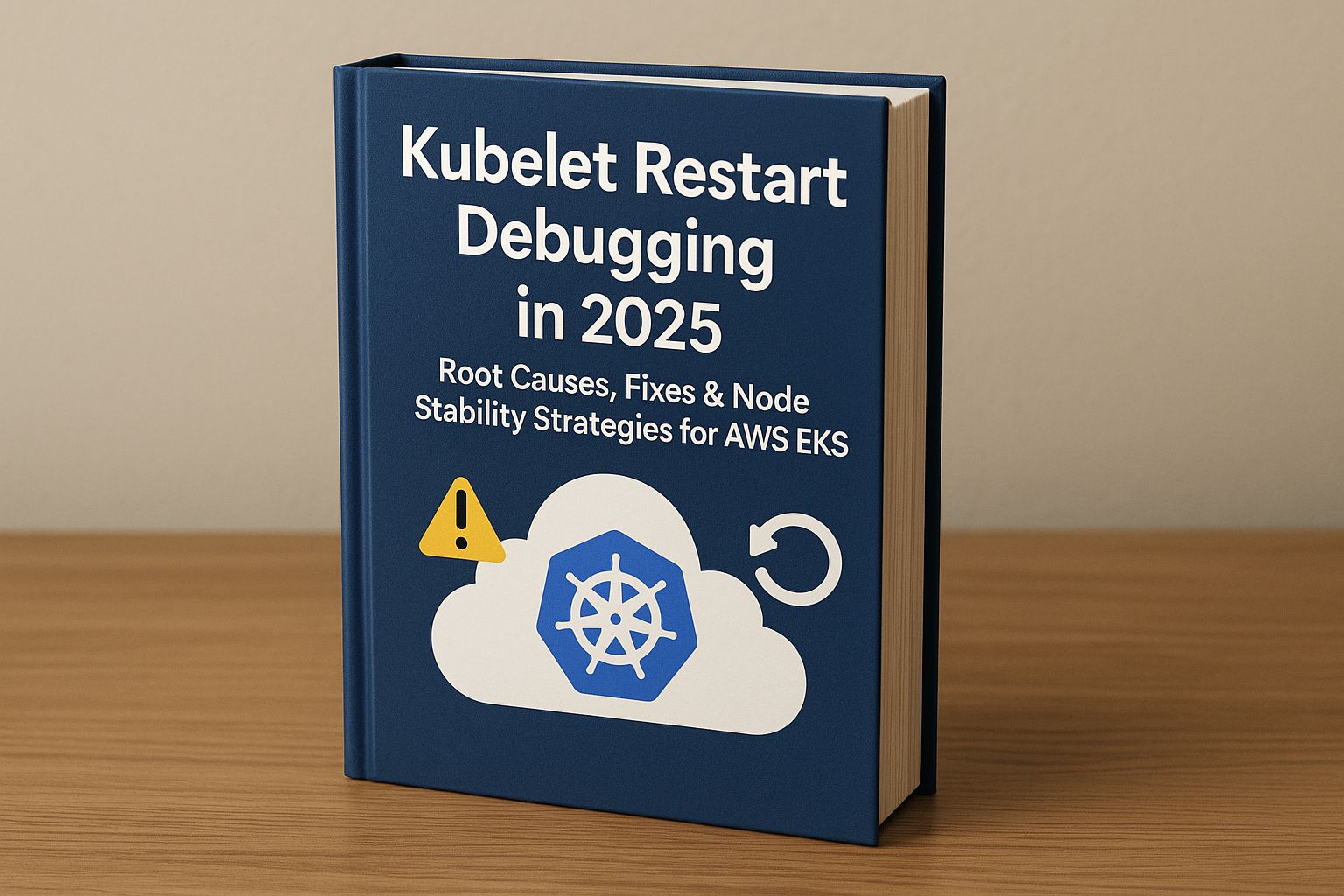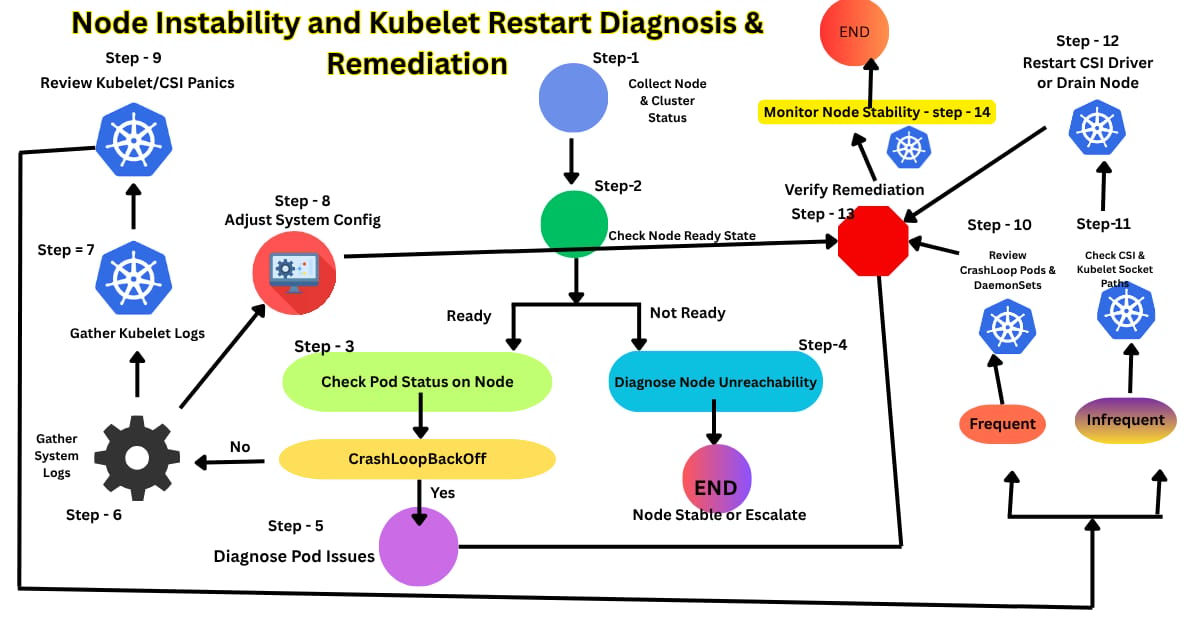- Red Signals
- Posts
- Kubelet Restart in AWS EKS: Causes, Logs, Fixes & Node Stability Guide (2025)
Kubelet Restart in AWS EKS: Causes, Logs, Fixes & Node Stability Guide (2025)
Fix Kubelet restarts in AWS EKS with this 2025 guide. Learn root causes, debug logs, CSI issues, and node stability strategies for production-grade clusters.

Kubelet is the heart of every Kubernetes node. When it restarts unexpectedly, you risk cascading failures—pods getting evicted, CSI volumes unmounting, nodes marked NotReady, and broken workloads.
In 2025, with Kubernetes 1.30+, Bottlerocket OS, cgroup v2, and evolving EKS architecture, understanding and hardening kubelet is non-negotiable for platform stability.
This blog walks through root causes, debugging flow, fixes, and advanced production-grade strategies to ensure node resilience.
Common Symptoms of Kubelet Restarts
Node status flips to
NotReadyRepeated pod evictions
Errors like
container runtime socket closed,Failed to start ContainerManager, or kubelet panic logsdmesgshows kubelet being killed (OOM)EBS volumes stuck, CSI plugins crash
GPU workloads failing after restart
Root Cause Categories
Category | Common Triggers |
|---|---|
Resource Pressure | OOM, no CPU left for kubelet |
Storage/CSI | Mount stuck, EBS race conditions |
OS & Systemd | systemd-oomd, DNS issues, service dependency cycles |
Security Agents | Falco, CrowdStrike interfering with kubelet runtime |
Kubelet Config Drift | Misconfigured flags, drift across versions |
Cloud Failures | IMDSv2 unresponsive, Nitro issues, disk I/O freeze |
Debugging Flow
Logs & Runtime Checks
journalctl -u kubelet -r
systemctl status kubelet
dmesg | grep -i kill
free -h && vmstat 1 5
ps aux --sort=-rss | head -n 10
df -h && iostat -xz 1 3
Kubelet Config Validation
cat /etc/kubernetes/kubelet/kubelet-config.json
kubelet --version

Command | Explanation |
|---|---|
| View reverse-chronological kubelet logs |
`dmesg | grep -i kill` |
| View available memory |
`ps aux --sort=-rss | head -10` |
| Check disk usage (node pressure) |
| Confirm node stability duration |
| Validate EC2 metadata service (IMDSv2) |
| Check kubelet config drift |
| Validate systemd health for kubelet |
Cloud Observability
CloudWatch: Log Insights on
/var/log/messages, kubelet logsNodeProblemDetector: Check
NodePressure,KernelDeadlock,KubeletOOMCheck EC2 metadata:
curl http://169.254.169.254/latest/meta-data/
Production-Ready Fixes
Memory & CPU Hardening
kubeReserved:
cpu: 200m
memory: 300Mi
systemReserved:
cpu: 100m
memory: 200Mi
Disk Pressure
Set eviction thresholds properly:
evictionHard:
memory.available: "100Mi"
nodefs.available: "10%"
Mount volume cleanup via automation scripts
Node Problem Detector Setup
kubectl apply -f https://raw.githubusercontent.com/kubernetes/node-problem-detector/master/config/default.yaml
Pin Stable Kubelet Version in EKS
eksctl create nodegroup ... --kubelet-extra-args='--node-labels=eks.amazonaws.com/nodegroup=stable --kubelet-version=1.29.3'
CI/CD + Automation
Jenkins/GitHub Actions Steps
SSH via SSM to new node
Run health-check script (validate kubelet uptime, journal logs)
Fail build if node uptime < 10 mins (indicating restart)
Chaos Engineering
Inject kubelet crash using AWS FIS or ChaosMesh
Validate ASG self-healing, workload migration
Real-World Scenarios
Case 1: EKS Node OOM
Kubelet killed silently by kernel
Pod disruption in production
Fixed via memory reservation + eviction tuning
Case 2: CSI Plugin Crash
EBS volume mount failure causes kubelet panic
Added health checks to restart CSI pods on failure
Case 3: Security Agent Interference
Falco + systemd race
Excluded kubelet and containerd dirs in Falco config
Recommended Tools
Tool | Purpose |
|---|---|
NodeProblemDetector | Kubelet/system pressure alerts |
eks-node-viewer | Visual node/kubelet status |
ChaosMesh | Kubelet crash simulation |
AWS Systems Manager | Remote node inspection |
CloudWatch Agent | Kubelet metrics/log shipping |
kubelet-config-linter | Detect misconfigurations |
Kubelet Restart Cheat Sheet
Symptom | Cause | Quick Check | Fix |
|---|---|---|---|
Frequent restarts | OOM |
| Add memory, tune |
Node NotReady | Disk full |
| Clean logs, expand volume |
CNI errors | Kubelet config drift |
| Align configs with AMI |
GPU pod crash | Driver not reloaded |
| Hook reload into startup |
Security & Compliance Notes
Log all kubelet restarts in CloudWatch
Audit
/etc/kubernetes/kubelet/using AWS ConfigFalco rules to detect unauthorized kubelet config changes
Alert on frequent kubelet crash patterns
What’s New in 2025
cgroup v2 now default: affects how memory is reported to kubelet
Bottlerocket: kubelet managed outside systemd — must debug via admin container
IMDSv2 failures common: EKS node bootstrap can fail silently
CSI drivers updated — sidecar version mismatch causes restarts
Kubelet auto-restarts not logged by systemd in minimal OSes (e.g., Bottlerocket)
Conclusion
In Kubernetes, the kubelet is your node’s pulse. Unstable kubelet = unstable node = broken workloads.
With evolving runtimes, security layers, and cloud-specific behaviors, kubelet stability must be proactively engineered, not reactively debugged.
Use this guide to:
Diagnose kubelet restarts confidently
Automate detection & healing
Stay ahead with 2025-grade strategies
Remember: The best time to fix a kubelet crash was yesterday. The second-best is before it takes down production.
Mastering Amazon EKS Upgrades: The Ultimate Senior-Level Guide
CrashLoopBackOff with No Logs - Fix Guide for Kubernetes with YAML & CI/CD
Multi-Tenancy in Amazon EKS: Secure, Scalable Kubernetes Isolation with Quotas, Observability & DR
10 Proven kubectl Commands: The Ultimate 2025 AWS Kubernetes Guide
Why Kubernetes Cluster Autoscaler Fails ? Fixes, Logs & YAML Inside
For more topics visit Medium , Dev.to and Dubniumlabs